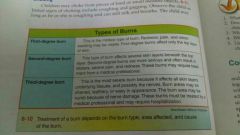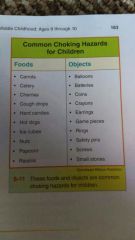![]()
![]()
![]()
Use LEFT and RIGHT arrow keys to navigate between flashcards;
Use UP and DOWN arrow keys to flip the card;
H to show hint;
A reads text to speech;
25 Cards in this Set
- Front
- Back
- 3rd side (hint)
|
The School Environment |
Most children enter kindergarten between the ages of 5 and 6. Children can organize their thoughts, memorize, and use symbols such as the alphabet to represent sounds. They can count, recognize colors, and take turns. |
|
|
|
Children this age need: |
* to hear praise *encouragement and approval |
|
|
|
Children this age want: |
*to please others, especially their teachers |
|
|
|
Children in middle childhood can: |
*follow two-step directions building up to multistep directions usually by the time they complete second grade. |
|
|
|
Physical Characteristics and Growth |
Typical growth in height averages between 2-3 inches per year. Adequate nutrition affects growth, height is mostly influenced by heredity. Boys and girls are similar in size and shape. |
|
|
|
Although their physical growth in height is slow and steady: |
They often start gaining weight faster. Their left or right hand dominance is well established. Their coordination and endurance increase. Hand eye coordination increases. |
|
|
|
Facial Features: |
Around 6 or 7 years of age children start to lose their baby teeth. Approximately 32 permanent teeth replace the 20 baby teeth children lose. |
|
|
|
Gross-Motor Skills |
"Look at me!" Each new achievement makes you feel grown up and independent. *running, jumping, climbing, and playing catch. |
|
|
|
Fine-Motor Skills |
The muscles in children's hands developed rapidly and as a result holding paintbrushes, pencils, building blocks, or instruments become easier |
|
|
|
Nutrition |
Compared to childhood, school-age children are less finicky about food. Their taste buds are not as sensitive and some are willing to explore new foods. Nutrient dense foods are rich in vitamins and minerals and contain relatively few calories. |

|
|
|
Childhood Obesity |
Body composition describes the proportion of body fat to lean mass (muscle,bone, and water) in a person's body. Overweight is defined as a high amount of body fat in relation to lean body mass. Obesity is an excessive amount of body fat. |
|
|
|
Childhood Malnutrition |
Malnutrition is a chronic problem caused by a significant lack of nutrients within a person's diet. |
|
|
|
Sleeping |
Children in middle childhood are usually great sleepers. They require about 10 hours of sleep per night. |
|
|
|
Strains and Sprains |
A strain occurs when the muscles or tendons are overworked and become injured. A sprain happens when ligaments within the joint are torn. Strains and sprains can be treated with R.I.C.E. or rest, ice, compress, elevate. |
|
|
|
Types of Burns: |

|
|
|
|
Common Choking Hazards for Children: |

|
|
|
|
Cognitive Characteristics and Growth |
Children in middle childhood are able to answer who, what, when, where, and why questions. |
|
|
|
Piaget's Concrete Operational Stage |
Children tend to focus on one part of a situation, Piaget referred to this way of thinking as centering in his preoperational stage of cognitive development. Children sometimes struggle with the concept of reversibility which means actions can be reversed. Children also understand the concept of time such as today, tomorrow, and yesterday. Piaget called this stage the concrete operational stage. |

|
|
|
Vygotsky's ideas |
Vygotsky believed that children learn best through social interaction. |
|
|
|
Gardner's theory of multiple intelligences |

Proposes that people learn and process information in different ways. Differences in learning based on abilities or expierences are termed learning diversity. Learning styles are methods of taking in and processing information. |

|
|
|
Executive Strategies |
skills used to solve problems. Executive strategies involve assessing problems,making goals, and developing a plan to meet that goal. |
|
|
|
Kohlberg's Theory of Moral Development |
Children in middle childhood are capable of making moral decisions. Is cheating on a test wrong? Some children may still be in the first level of moral development or post conventional morality. By latter years children enter the second stage of moral development or conventional morality "good" or "bad" |
|
|
|
Socio-emotional Characteristics and Growth |
Erikson describes his psychosocial stages of development, children in middle childhood are often in the stage of industry versus inferiority. Children becoming more independent and as a result learning more skills. |

|
|
|
Special Needs |
Hyperopia or farsightedness, an eye condition that results in difficulty sewing objects that are near. Myopia or nearsightedness,an eye condition that results in difficulty seeing objects that are far away. Dyslexia is characterized by difficulty understanding and recognizing letters, symbols, and sentence meanings. |

|
|
|
Special Education |
Mainstreaming is a term to describe the placement of special needs students who show the ability to keep up with the curriculum into regular classrooms. Inclusion is a term used to describe the placement of special needs students into a regular classroom despite their inability to keel up academically. |

|

